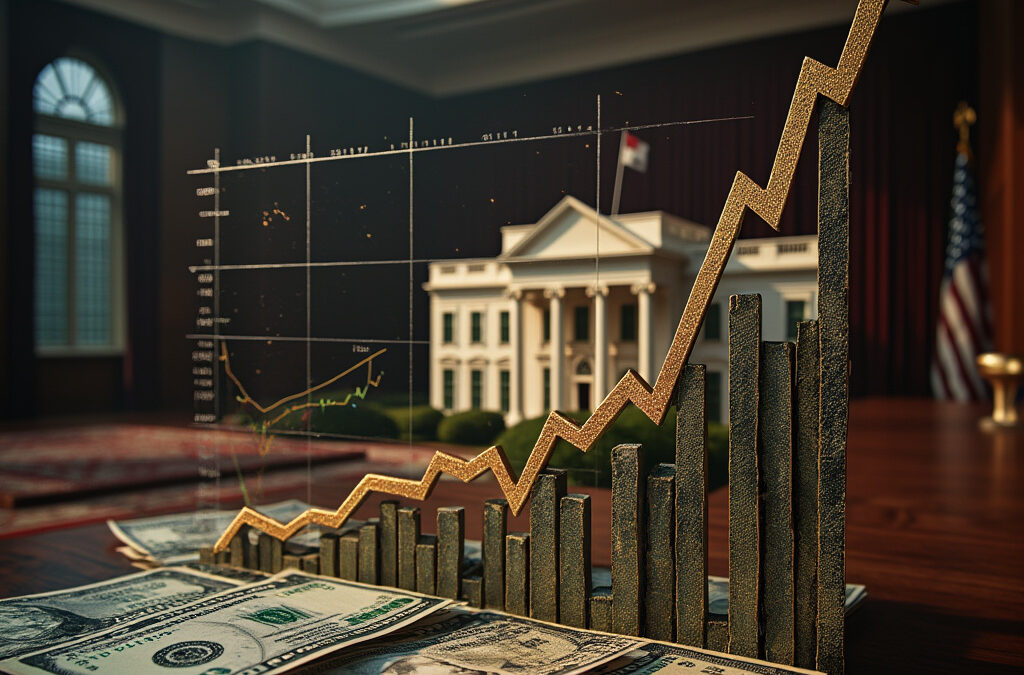Trump and the Fed Complicate the Stock Market’s Historic Bull Run
The U.S. stock market has been on a historic bull run, defying expectations and delivering strong returns for investors. However, the economic landscape is growing increasingly complex, with two major forces—President Donald Trump’s policies and the Federal Reserve’s interest rate decisions—introducing significant uncertainty. As 2025 unfolds, these factors are reshaping the outlook for growth, inflation, and market performance.
President Trump’s return to office has brought a familiar yet contentious economic agenda. His administration has signaled a return to tariff-heavy trade policies, particularly targeting China, Mexico, and Canada. These measures, including a proposed 10% tariff on Chinese goods and 25% tariffs on Mexico and Canada, are expected to take effect as early as February 1, 2025. While these policies aim to protect American industries, they also carry the risk of higher inflation and slower investment growth.
Meanwhile, the Federal Reserve has maintained a cautious stance on interest rates. After cutting rates three times in 2024, the central bank held steady in January 2025, keeping the federal funds rate unchanged. However, the Fed’s “dot plot” forecast suggests two potential rate cuts in 2025, each of 25 basis points. Market traders are split on the outlook, with 60% betting on at least two cuts and 40% predicting fewer reductions or none at all. This uncertainty is creating ripples in financial markets, as investors weigh the implications for borrowing costs and economic growth.
The interplay between Trump’s policies and the Fed’s rate decisions is further complicated by the global economic backdrop. The International Monetary Fund (IMF) projects global growth at 3.3% for both 2025 and 2026, slightly below the historical average of 3.7% from 2000 to 2019. While the U.S. economy is expected to outperform other major economies, the overall outlook remains muted. Global inflation is also on a downward trajectory, with headline inflation projected to fall to 4.2% in 2025 and 3.5% in 2026. However, emerging markets may lag behind advanced economies in returning to target inflation levels.
For investors, the current environment presents both challenges and opportunities. High-yield savings accounts and certificates of deposit (CDs) are offering historically high returns, with rates in the mid- to upper-4% range. These vehicles allow savers to lock in attractive yields, even as the future trajectory of interest rates remains uncertain. At the same time, the stock market’s historic bull run is being tested by rising inflationary pressures and the potential for slower growth.
As the year progresses, the actions of the Trump administration and the Federal Reserve will be closely watched. Will the Fed’s rate cuts provide enough stimulus to offset the economic drag of tariffs? How will investors navigate the twin challenges of inflation and slower growth? The answers to these questions will shape the direction of the stock market and the broader economy in 2025 and beyond.

Delving Deeper into the Economic Landscape
The U.S. economic outlook for 2025 is further complicated by the interplay of President Trump’s policies and the Federal Reserve’s cautious approach to monetary policy. While the extension of Trump’s tax cuts and deregulation measures are expected to provide a modest boost to consumption and investment, the simultaneous ramp-up in tariffs could offset these gains. The administration’s trade policies, particularly the proposed tariffs on China, Mexico, and Canada, are anticipated to lead to higher inflation and slower investment growth. This dual impact raises concerns about the overall growth trajectory for the year.
The Federal Reserve’s stance on interest rates adds another layer of complexity to the economic picture. Despite maintaining the federal funds rate in January 2025, the Fed’s “dot plot” forecast suggests two potential rate cuts of 25 basis points each in 2025. This outlook reflects the central bank’s balancing act between supporting growth and managing inflationary pressures. However, market traders remain divided, with 60% expecting at least two rate cuts and 40% predicting fewer reductions or none at all. This uncertainty underscores the challenges the Fed faces in navigating the current economic environment.
Global inflation trends also play a critical role in shaping the economic outlook. According to projections, global headline inflation is expected to decline to 4.2% in 2025 and 3.5% in 2026, with advanced economies likely to converge to target levels earlier than emerging markets. This downward trajectory in inflation could provide some relief to consumers and businesses, though the impact of tariffs and supply chain disruptions may counteract these trends in the near term.
For investors, the current environment presents a mix of opportunities and challenges. High-yield savings accounts and CDs continue to offer attractive returns, with rates in the mid- to upper-4% range. These financial instruments provide a safe haven for savers looking to capitalize on historically high rates, even as the future trajectory of interest rates remains uncertain. At the same time, the stock market’s historic bull run is being tested by rising inflationary pressures and the potential for slower growth.
The Trump administration’s policies and the Federal Reserve’s interest rate decisions are not the only factors influencing the economic outlook. Consumer behavior and business confidence also play a significant role. With inflation expected to remain elevated in the near term, consumers may face tighter wallets, potentially leading to reduced spending. Businesses, on the other hand, may delay investment decisions due to uncertainty over trade policies and interest rates. These dynamics could further slow growth and complicate the Fed’s efforts to achieve its economic goals.
As the year progresses, the interplay between these factors will be closely monitored by economists, investors, and policymakers. The ability of the Trump administration and the Federal Reserve to navigate this complex landscape will be critical in determining the course of the U.S. economy in 2025 and beyond.

Conclusion
The U.S. stock market’s historic bull run continues to face significant challenges in 2025, as President Trump’s policies and the Federal Reserve’s interest rate decisions create a complex economic landscape. While Trump’s tariff-heavy trade policies aim to protect American industries, they risk fueling inflation and slowing investment growth. Meanwhile, the Fed’s cautious approach to rate cuts leaves markets uncertain about the future trajectory of borrowing costs and economic growth.
Global economic trends further complicate the outlook, with muted growth projections and declining inflation offering mixed signals for investors. High-yield savings accounts and CDs provide attractive returns for savers, but the stock market’s resilience will depend on how effectively policymakers navigate these headwinds. As 2025 unfolds, the interplay between Trump’s policies, the Fed’s rate decisions, and global economic conditions will shape the direction of the U.S. economy and financial markets. Investors must remain vigilant, balancing opportunities with risks in this uncertain environment.
Frequently Asked Questions (FAQs)
-
How do Trump’s trade policies impact the stock market?
Trump’s tariffs on China, Mexico, and Canada could lead to higher inflation and slower investment growth, posing challenges for the stock market. However, certain industries may benefit from protective measures, creating opportunities for selective gains.
-
Will the Federal Reserve cut interest rates in 2025?
The Fed’s “dot plot” forecast suggests two potential rate cuts of 25 basis points each in 2025. However, market traders are split, with 60% expecting at least two cuts and 40% predicting fewer reductions or none at all.
-
What investment strategies are best in this economic climate?
Investors should consider high-yield savings accounts and CDs for safe, attractive returns. For risk-tolerant investors, sectors less exposed to trade tensions and inflationary pressures may offer opportunities for growth.
-
How does global inflation impact the U.S. economy?
Global inflation is projected to decline, offering some relief to consumers and businesses. However, U.S. inflation may remain elevated due to tariffs and supply chain disruptions, complicating the economic outlook.
-
What is the outlook for the U.S. economy in 2025?
The U.S. economy is expected to outperform other major economies, but growth will likely be muted due to trade tensions, inflationary pressures, and uncertainty over interest rates. Consumer spending and business investment will be key factors to watch.

